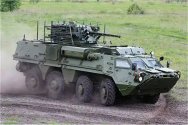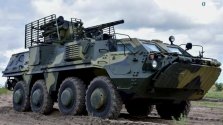Overview of German Leopard 1 tanks preparing for the counteroffensive of the Ukrainian army. Denmark and Germany will transfer 80 Leopard 1 tanks removed from storage to Ukraine, the tanks will arrive by June 1, and then the offensive of the Ukrainian army will apparently begin. Judging by the number, these tanks will soon be the main figures in military reports. The Leopard 1 tank began to be developed in 1956 by France and Germany, the French constantly reduced their participation in the development and the tank put into service in 1965 can be called German. The tank was designed for battles with Soviet T-55 and T-64 tanks at medium distances. Judging by open data, the tank's armor is weak and breaks through from short distances even with conventional infantry fighting vehicles and almost all types of anti-tank systems. The frontal armor of the tank is from 25 to 70 mm, for comparison, in the T-72M tank it is up to 410 mm. Perhaps in Ukraine, the armor of the tank will be reinforced with dynamic protection units. Based on this, the main strategy of the tank is to work from behind ambushes and from a long distance. The tank went through seven upgrades, the last one was in 1987, the tank received the A5 index, and Ukraine will receive this version. In 1994, 5 tanks met with three Serbian T-55 tanks, as a result of the battle, all T-55 tanks were damaged, one Leopard tank was damaged. Canadian versions of the Leopard 1 tank with reinforced composite armor were in the 2000s in Afghanistan, they were praised for their rate of fire and aiming accuracy, but were criticized by the engines due to erratic operation in dust and at high temperatures. The tank is equipped with a British L7A1 semi-automatic licensed 105 mm gun and, depending on modification, 7.62 or 12.7 mm machine guns. The crew of the tank is 4 people. Power plant with a capacity of 820 hp provides a maximum speed of up to 65 km / h with a power reserve of up to 600 km. Tank weight up to 42 tons.
You are using an out of date browser. It may not display this or other websites correctly.
You should upgrade or use an alternative browser.
You should upgrade or use an alternative browser.
Ukraine Military News, Reports, Data, etc.
- Thread starter Kich
- Start date
Review of Anglo-French cruise missiles Storm Shadow/SCALP of the Ukrainian Army. To carry out the counteroffensive, Britain supplied Ukraine with Storm Shadow long-range cruise missiles. The Anglo-French Storm Shadow cruise missile began to be developed in 1994 on the basis of the Apache cruise missile developed in France. The missile was put into service in 2001, the French version of the missile is designated by the abbreviation SCALP-EG. The missile is equipped with a turbojet engine and has a flight speed of up to 960 kilometers per hour. That is, the distance from Kyiv to Belgorod, it can fly in about 20 minutes. The missile was used in Iraq and Libya, the target destruction rate was 97% according to the Italian Air Force, it is worth noting that air defense almost did not work there. In 2018, it was reported that all eight missiles launched from Tornado aircraft were shot down by Syrian air defense forces, this information was denied by the Pentagon, but later the Russian Ministry of Defense showed fragments of missiles. The missile is programmed before launch, taking into account the air defense data and the target. The missile flies autonomously along the route to the target, at an altitude of 30-40 meters, guided by GPS data and cartography, close to the target, the missile gains altitude and then goes into a dive. Climbing is intended to achieve a higher probability of identifying the target with a thermographic camera, climbing may not be applied, but the accuracy of the missile is reduced. You should not expect any significant changes from the supply of missiles, like all cruise missiles, they are easy to shoot down if the area is covered by modern air defense systems, with luck, a cruise missile can even be shot down with MANPADS. The range of the rocket is approximately 560 km when launched from an aircraft, the mass of the rocket is 1300 kg, the mass of the warhead is 450 kg. The cost of the Storm Shadow missile is €850,000 as of 2011.
Published footage of the crew of the American 155-mm self-propelled howitzer M109 of the army of Ukraine. The video shows the process of preparing a howitzer for a shot by the crew of the Ukrainian army. Earlier, Ukraine received M-109 howitzers of different versions from Latvia, Norway, Great Britain and Italy. Howitzers began to be produced in 1962 and were delivered to many countries of the world. Over the years, the howitzer has been upgraded many times, the latest version being the M109A7. The howitzer uses separate cartridge loading charges. The rate of fire of the howitzer is up to 4 rounds per minute.
Details about Danish Caesar 8x8 howitzers received by Ukraine. The first footage from one of the 19 155-mm Caesar self-propelled guns transferred by Denmark to Ukraine on the Tatra T815 chassis has been published. In 2017, Denmark ordered these self-propelled guns from France, but the self-propelled guns could not be received for a long time, as they corrected defects associated with the gearbox, gun barrels and general design adjustments. On January 19, 2023, the Danish Minister of Defense announced that a decision had been made to transfer all 19 self-propelled guns to Ukraine. At the same time, the minister admitted that the ACS ordered by Denmark on the Tatra T815 chassis had structural defects, Ukraine was informed about this. Differences between the Danish CAESAR self-propelled guns on the Tatra T815 chassis and the French, an automated gun loading system and an armored cabin. The calculation of self-propelled guns was reduced from five to 3 people, the ammunition load was increased from 18 to 36 shells. The mass of self-propelled guns has increased from 18 to 32 tons. The Caesar 8x8 self-propelled guns are equipped with a 410 hp Tatra V8 engine.
Overview of the American boats Sea Ark Dauntless of the Ukrainian army.
Ukraine has published footage of exercises with the landing of a river assault using American boats Sea Ark Dauntless. The Sea Ark Dauntless high-speed patrol boat is manufactured by US Watercraft and is used by the US Navy to protect naval bases and operations of landing and sabotage forces. The US has 117 of these boats, but they are being replaced with newer models. The 11m aluminum boats can be armed with two 7.62mm M240 machine guns or two 12.7mm M2 Browning machine guns. Some models of boats can be equipped with grenade launchers. Sea Ark Dauntless type boats are capable of taking on board seven people and are equipped with two engines with a total power of 850 hp. and two Hamilton water cannons. The boat develops speed up to 85 km/h.
Ukraine has published footage of exercises with the landing of a river assault using American boats Sea Ark Dauntless. The Sea Ark Dauntless high-speed patrol boat is manufactured by US Watercraft and is used by the US Navy to protect naval bases and operations of landing and sabotage forces. The US has 117 of these boats, but they are being replaced with newer models. The 11m aluminum boats can be armed with two 7.62mm M240 machine guns or two 12.7mm M2 Browning machine guns. Some models of boats can be equipped with grenade launchers. Sea Ark Dauntless type boats are capable of taking on board seven people and are equipped with two engines with a total power of 850 hp. and two Hamilton water cannons. The boat develops speed up to 85 km/h.
Overview of Ukrainian UJ-22 UAVs attacking Moscow on May 30. A large-scale Ukrainian UAV attack took place today at 4 am on Moscow and the Moscow region. According to the latest data, 32 UAVs of various models were involved in the attack. One of the used UJ-22 Airborne UAVs manufactured by the Ukrainian company Ukrjet. The UAV is made of carbon fiber and equipped with a communication system with two independent data transmission channels. The UAV can fly at an average speed of 160 km/h, at a range of up to 800 km, with a maximum flight altitude of 6000 meters and a takeoff weight of 85 kg. UAV payload weight 20 kg. Flight time up to 14 hours. As it turned out, part of the drones carried an industrial shaped charge KZ-6 with a warhead mass of 1.8 kg. As a result of the attack, 19 UAVs were reportedly shot down by Russian air defenses, 10 UAVs fell on their own in the fields, and 3 UAVs crashed into residential buildings. The remains of the UAV are studied by specialists and local residents who took them as souvenirs. As a result of the UAV attack, none of the residents in Moscow was seriously injured, two people sought medical help.


